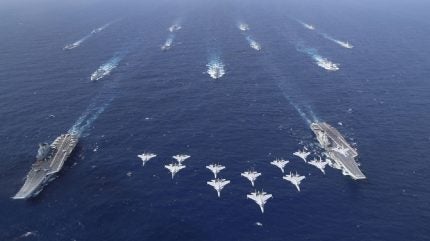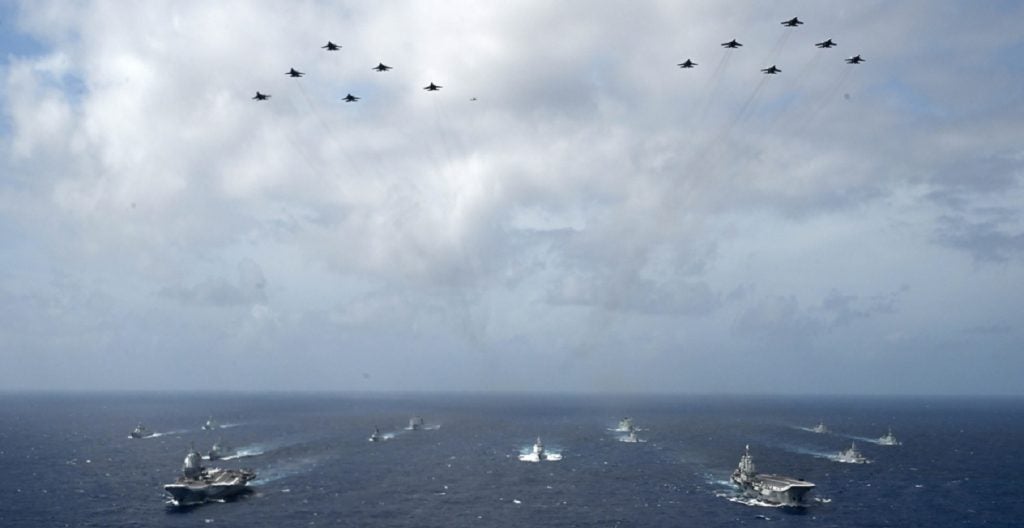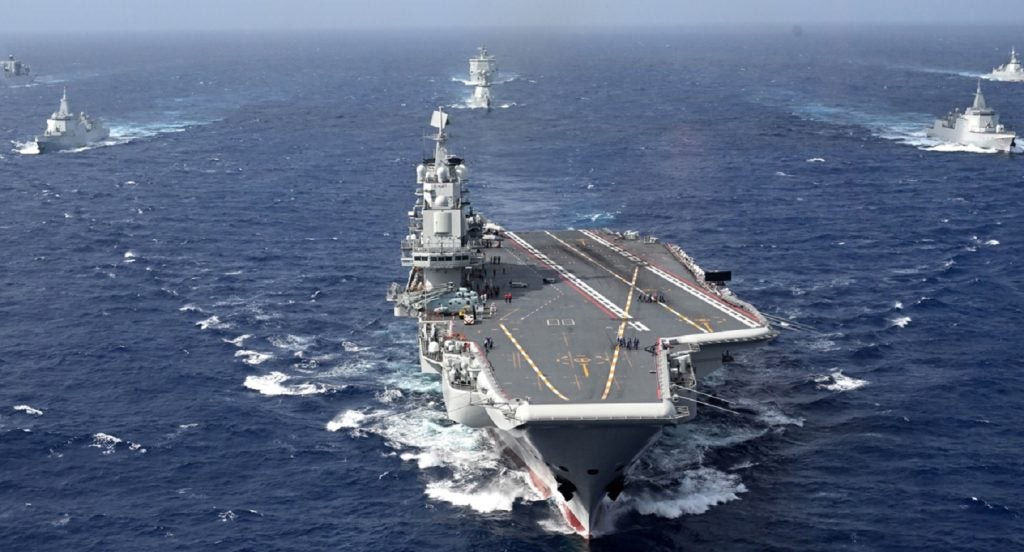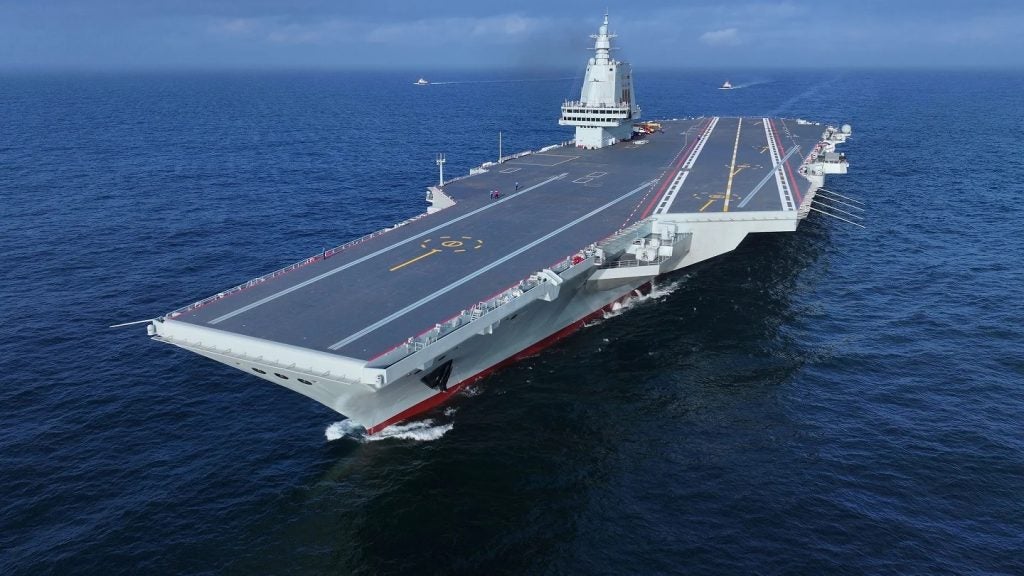
Recently released images of China’s People’s Liberation Army Navy (PLAN) conducting joint exercises with two aircraft carriers point to the pace of progress in the country’s naval power projection aims, with the Liaoning and Shandong performing flight operations within a single carrier strike group (CSG).
In just over a decade, China has advanced through two generations of aircraft carriers and is already developing third and fourth generations, as the PLAN comes closed to parity with the very largest vessels in the US Navy.
Outside of the United States, few nations have the ability to conduct dual carrier CSG operations. The UK has a possible capability to have its two Queen Elizabeth-class carriers operational at the same time but has just 34 F-35B carrier-capable fighters available.
The Indian Navy also operates two aircraft carriers, the INS Vikramaditya and INS Vikrant, the former a modified Russian Kiev-class platform, while the latter is a new build whose design is heavily influenced by its older sister ship.
Japan is modifying its two Izumo-class ‘helicopter destroyers’ into full flat deck platform capable of operating fixed-wing aircraft such as the F-35B, following the same configuration as the UK’s Royal Navy, but this capability is still several years away.
The US Navy maintains a fleet of 11 dedicated aircraft carriers, including the forward-deployed Nimitz-class carrier USS Ronald Reagan committed to the Pacific Area of Operations and the US 7th Fleet, based out of Yokosuka, Japan.
PLAN’s twin carrier CSG shows off J-15 airwings
According to China’s Ministry of National Defense (MND), posting on 31 October, the carriers Shandong and Liaoning carriers carried out dual flat deck operations in the South China Sea in order to “enhance integrated combat capability”.
In addition, the exercise was also part of recently concluded training for the Liaoning CSG to test combat capabilities in the Yellow Sea, East China Sea, and South China sea, stated the MND.

Analysis of the imagery released by the MND shows the Shandong sailing in formation with 18 J-15 naval fighters and potentially two Z-18 maritime helicopters on its deck, an airwing that comprises around half of the carrier’s full load, which is thought to number up to 40 fixed- and rotary-wing aircraft.
The Liaoning is shown with just two J-15 fighters on its flight deck, indicating that the 12 airborne J-15 fighters seen in released imagery were operated from the carrier.
The fighters seen in the released imagery comprise a mixed group of A and B models, with the latter variant capable of catapult assisted take off operations, although can operate in a STOBAR configuration.
China sprinting through carrier generations
The Liaoning, China’s first Type 001 aircraft carrier, was delivered and commissioned to the PLAN in September 2012, having been acquired from Ukraine in 1998. The vessel is a former Admiral Kuznetsov-class aircraft carrier, designed and operated by the Soviet Union briefly during the Cold War before finding itself unwanted by Ukraine after the country’s emergence in 1991.
Displacing in the region of 50,000-60,000 tonnes depending on the load, the Liaoning was modified and modernised after acquisition to act as an entry-level platform into world’s carrier-capable nations.

The Type 002 Shandong is based on the Liaoning, but built entirely in China, with both being short take off, brake assisting recovery (STOBAR) platforms, meaning that aircraft perform take-off from the flight deck under their own power and brought to a halt upon landing with the assistance of brake wires.
US and French carriers are similar, except aid take off through steam or electrically powered catapult systems (CATOBAR) to allow for greater payload. The UK’s Queen Elizabeth-class carriers use neither catapults to aid take-off nor brake assisting recovery, rather relying on the short take off, vertical landing (STOVL) capabilities of the F-35B fighter.
The PLAN is also working up its new Type 003 carrier Fujian, which is a large CATOBAR aircraft carrier displacing approximately 85,000 tonnes and is comparable in size to the US Navy’s former Enterprise-class platforms, the last of which left service in 2012.

While the US Navy still maintains its quantitative advantage compared to the PLAN’s carrier fleet, the progress made by China in the 12 years since it began naval aircraft carrier operations is remarkable, progressing through Cold War-era platforms to an equivalence of US Navy platforms that left service the same year that Liaoning was commissioned.
China is also developing the 110,000 tonne Type 004 aircraft carrier class, comparable in size to the new Ford class just beginning to enter service with the US Navy and will be the first PLAN flat decks to be powered using nuclear propulsion. It is thought up to four of the Type 004 will be built, potentially entering service from the late 2020s and early 2030s.
Given China’s focus on the Western Pacific, this could see PLAN flattops outnumbering those based in the US Navy’s 7th Fleet AOR, even with augmentation from allies such as Japan.




